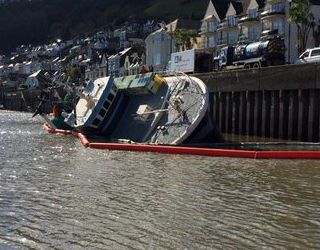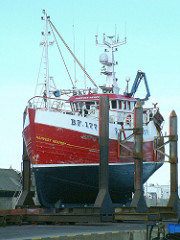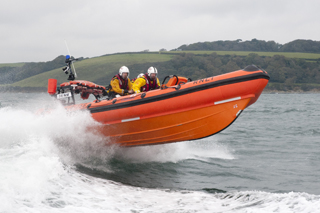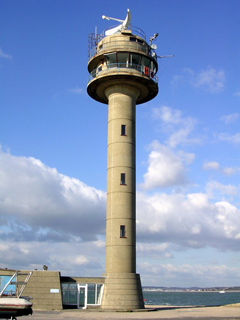Things That Go Bump In The Night
 About two months ago the papers were full of pictures of a French trawler lying on its side in Dartmouth Harbour. It had take shelter there to avoid a bad storm and the crew, no doubt dead tired, had tied up against the harbour wall which is right in front of the town. Maybe at their home port they were used to lying alongside a wall at all states of the tide, no cares as their boat went safely up and down. But Dartmouth is different.
About two months ago the papers were full of pictures of a French trawler lying on its side in Dartmouth Harbour. It had take shelter there to avoid a bad storm and the crew, no doubt dead tired, had tied up against the harbour wall which is right in front of the town. Maybe at their home port they were used to lying alongside a wall at all states of the tide, no cares as their boat went safely up and down. But Dartmouth is different.
Though very deep it is a tidal harbour and the water retreats twice each day from the walls, leaving just about a couple of feet. The crew turned in, shattered after their experience and, in the early hours of the morning, their world tipped over. As the tide ebbed the trawler dropped until the keel hit the muddy bottom. It was their bad luck that she was too close to the wall to lie against it so could only go the other way, outwards , gently and elegantly, until she lay on her side. Long before this the crew would have realised something was wrong but it would be impossible to stop the inevitable. Abandon ship was the only possible option. No one was in any danger but it was impossible to get off the ship and the RNLI was pressed into service. When daylight came the true problem was revealed.
 This trawler, like most of them, had V shaped bottom and keel. This is true of most trawlers and sailing yachts and, if it is necessary to lie against a wall where it is known to dry, the correct thing to do is to make sure the vessel is not right against the wall but two or three feet away so that there is room for her to lie over against the wall for support. In cases where it is common practice for this to happen with a particular ship then things like chains, full jerry cans, anything heavy is always carried on the side of the ship which will be against the wall.
This trawler, like most of them, had V shaped bottom and keel. This is true of most trawlers and sailing yachts and, if it is necessary to lie against a wall where it is known to dry, the correct thing to do is to make sure the vessel is not right against the wall but two or three feet away so that there is room for her to lie over against the wall for support. In cases where it is common practice for this to happen with a particular ship then things like chains, full jerry cans, anything heavy is always carried on the side of the ship which will be against the wall.
Then, when she touches, the weight will be on the wall side so that she naturally leans that way. If it is something which only happens from time to time, like with a yacht, then the anchor chain will be brought up and ranged along the correct side to make her lean.
Sometimes, just to be sure of a good night’s sleep, a rope will be run from the masthead to a secure point on the quay to make sure that she cannot lean outwards. Earlier this year we had the instance of the three American sailors who. not very expertly, were trying to sail from Europe back to America. Having been rescued by various agencies they wound up in Padstow and again got into difficulty. With no experience of drying harbours they took no precautions when they put her against a wall and over she went.
Some vessels are designed to sit on the bottom. The Thames barge and the earlier wherries were all flat bottomed to allow this. Some yachts have two or three keels to prop them up. We regularly see coasters come up to load scrap metal at Truro and they sit on the bottom at low water. These vessels are designed for that purpose, though it is not only ships like these which have flat bottoms.
 Big ships, like the latest cruise liners which we see off Falmouth, are probably also flat bottomed. In the last forty years wisdom in ship design has changed because as cruise ships got larger to accommodate more passengers the old thinking of a deep pointed keel meant that the draught got deeper and deeper so they could not enter a lot of harbours. These big cruise liners get their stability from being very wide with huge water and sewage tanks at the bottom of the hull as ballast, allowing shallower draught so they can enter port.
Big ships, like the latest cruise liners which we see off Falmouth, are probably also flat bottomed. In the last forty years wisdom in ship design has changed because as cruise ships got larger to accommodate more passengers the old thinking of a deep pointed keel meant that the draught got deeper and deeper so they could not enter a lot of harbours. These big cruise liners get their stability from being very wide with huge water and sewage tanks at the bottom of the hull as ballast, allowing shallower draught so they can enter port.
But to go back to the original incident and the fact that the crew had to be ‘rescued’ by the RNLI inflatable. Just another example of the huge variety of work which that amazing organisation does. This time for them it was an easy call out – albeit in the middle of the night. Tomorrow that same RHIB might be picking up visitors who had got trapped by the tide – or standing by at the foot of a cliff while the Cliff Rescue try to recover a dog which has fallen over.
We frequently see them passing our Lookout to help people who had run out of fuel, got caught in fishing nets or, perhaps, suffered a minor but incapacitating injury while on a sailing boat. The big seagoing craft are just as active with a huge variety of calls. Standing by a trawler twenty miles offshore which has developed a leak. Calls on a black and stormy night to a ship in serious trouble, engine failed, and drifting towards the rocks. Sometimes these end in tragedy – remember the loss of the ‘Solomon Browne’ while trying to rescue the crew of the ‘Union Star’ one dark December night in 1981. These crews are all volunteers.
So are we in the N.C.I.. We come from all walks of life, of all ages, men and women who are looking to do something a bit different in the way of voluntary work. Not for one moment would I suggest that our work carries the danger or needs the skills of the Lifeboats. But we are still an important part of the Emergency Services associated with the sea and the coastline. Our work is also immensely varied.
There are some 50 stations now in operation with several more in the pipeline. Mainly our work is with the leisure water user and small local fishing craft but, in some places, large shipping has to be taken into account. Calshott Tower on Southampton Water is one of those where the leisure sailor is in close proximity to large commercial shipping.
At the other end of the scale St Ives ( North Cornwall) in January of this year reported a large sewage leak from South West Water’s macerating plant! Worms Head frequently reports people cut off by the tide as they misjudge it over the causeway while in August Boscastle reported that a large navigation buoy, a channel marker, had just floated past! When they are not doing things like this Boscastle have a couple of miles of Coast Path in their view and keep watch on that.
CALSHOTT TOWER
 Our work at Pednvadan has not, so far, produced anything quite so bizarre. We have had kite surfers in difficulties, a yacht with a broken forestay, the odd RHIB running out of fuel. Our beaches are very busy and there are no Lifeguards so, to some extent, we fill that gap, not by putting up flags but by watching over swimmers, kayakers, surfers etc to make sure that, if they get into trouble, we can see to it that help is on the way.
Our work at Pednvadan has not, so far, produced anything quite so bizarre. We have had kite surfers in difficulties, a yacht with a broken forestay, the odd RHIB running out of fuel. Our beaches are very busy and there are no Lifeguards so, to some extent, we fill that gap, not by putting up flags but by watching over swimmers, kayakers, surfers etc to make sure that, if they get into trouble, we can see to it that help is on the way.
We also get a friendly wave from the local professional fishermen as they acknowledge that there might be a time when they need help and it is nice to see a face at our Lookout window. Oh- we do have the occasional casualty on the Coast Path. Some years ago a lady broke her arm when she fell not far from the Lookout. Our Watchkeeper arranged an ambulance and provided a temporary splint from a Pooh stick. Not the A.A.Milne type I might add. Yes, we do have members who bring their dogs down on watch.
A number to ring if you would like to come and help – we do need you. Try Sue on 01872-530500 or Christine on 01326-270681.
